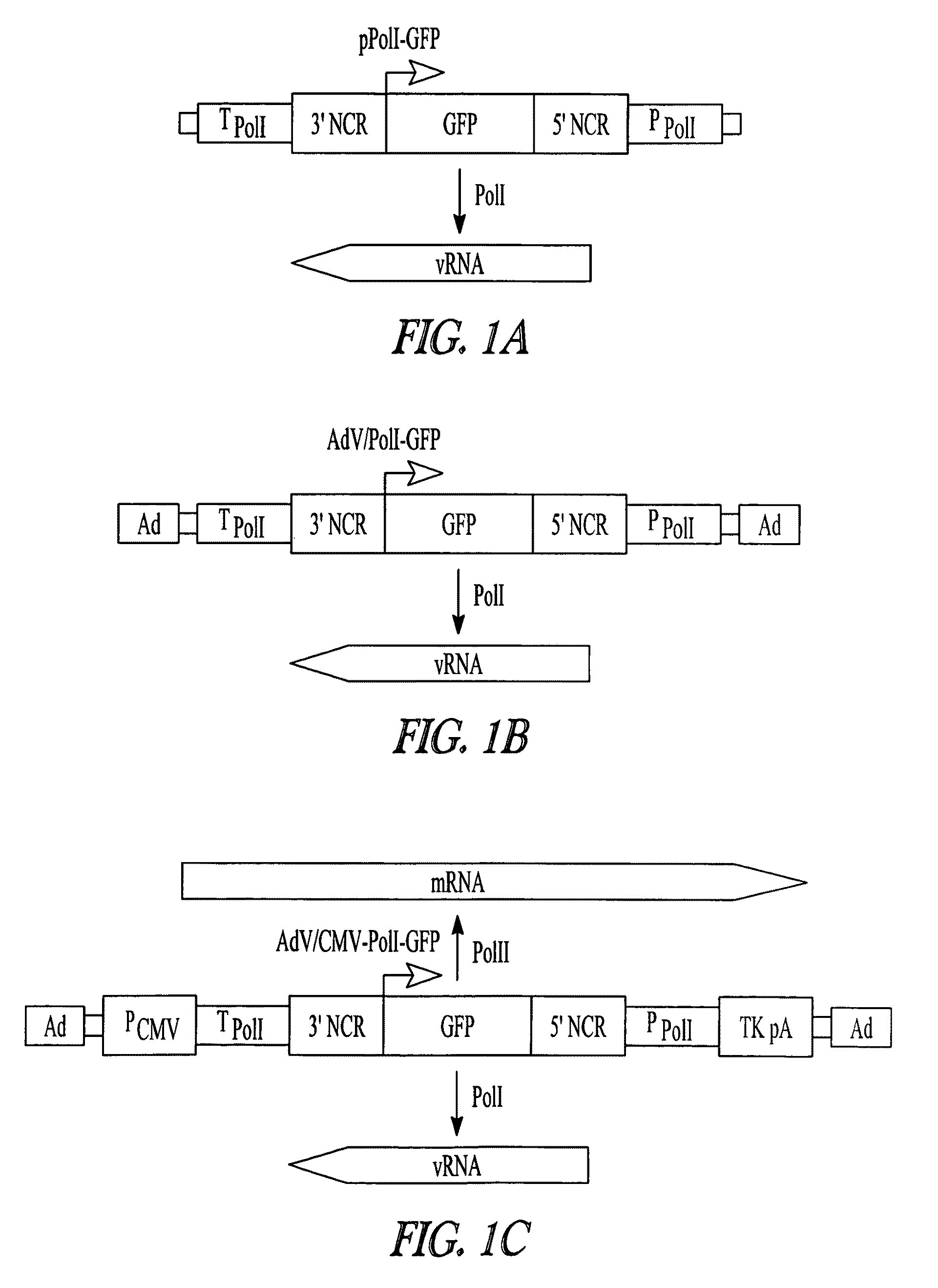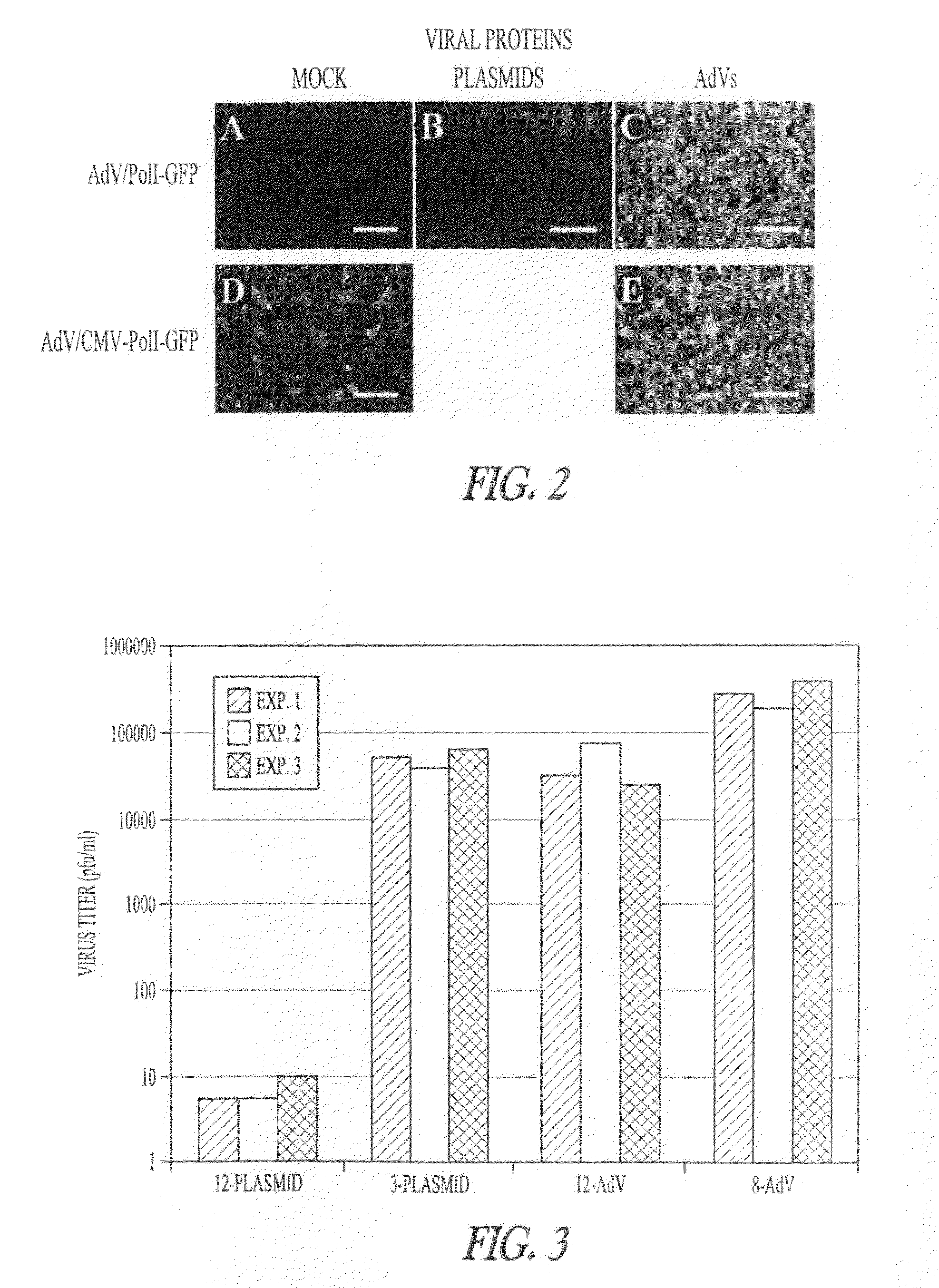Adenoviral vectors for influenza virus production
a technology of influenza virus and adenoviral vector, which is applied in the field of adenoviral vectors for influenza virus production, can solve the problems of lethal outcomes, time-consuming and cumbersome, and millions of influenza-related deaths, and achieves high virus yield, safe administration, and high efficiency of gene transfer
- Summary
- Abstract
- Description
- Claims
- Application Information
AI Technical Summary
Benefits of technology
Problems solved by technology
Method used
Image
Examples
example i
[0123]AdV-mediated synthesis of influenza vRNA. In plasmid-based reverse genetics systems, plasmids possessing the cDNA of viral genes under the control of the human PolI promoter and the mouse PolI terminator have been used for vRNA synthesis (Neumann et al., 1999). The cDNA corresponding to the transcriptional region in pPolI-GFP (FIG. 1A; Neumann et al., 2000) was cloned into pAd / PL-DEST (Invitrogen), which contains E1 and E3-deleted human adenovirus type 5 genome sequence as a viral vector backbone, by means of the Gateway system using LR clonase (Invitrogen). Transfection of the resultant plasmid into 293A cells produced AdV for the synthesis of a reporter vRNA (AdV / PolI-GFP; FIG. 1B).
[0124]To test whether AdV / PolI-GFP can produce the reporter vRNA in Vero cells, that AdV was transduced into cells. These cells were simultaneously transfected with four plasmids to express the A / WSN / 33(H1N1, WSN) viral polymerase subunits (PB2, PB1, and PA) and NP, which are necessary and suffici...
example ii
[0132]H5N1 influenza A viruses continue to cause fatal human infections. The epidemic regions have expanded from Asia to Europe and Africa, raising concerns over a possible pandemic (Horimoto et al., 2005). Currently, pre-pandemic H5N1 vaccines are being stockpiled in many countries. These inactivated vaccines were produced from viruses propagated in chicken embryonated eggs following inoculation of the vaccine seed virus, generated by cloned cDNA-based reverse genetics in a 12-plasmid (Foder et al., 1999; Neumann et al., 1999) or 8-plasmid (Hoffman et al., 2000) system, in an African green monkey Vero cell line (Horimoto et al., 2006; Nicolson et al., 2005; Subbarao et al., 2003; Webby et al., 2004; Wood et al., 2004) that is approved for human vaccine production (e.g., polio and rabies vaccines, see, Montagnon et al., 1999). However, the generation of the H5N1 vaccine seed viruses in this cell line is not optimal due to its low plasmid transfection efficiency. In a pandemic situat...
PUM
| Property | Measurement | Unit |
|---|---|---|
| fluorescence microscopy | aaaaa | aaaaa |
| exposure time | aaaaa | aaaaa |
| fluorescence- | aaaaa | aaaaa |
Abstract
Description
Claims
Application Information
 Login to View More
Login to View More - R&D
- Intellectual Property
- Life Sciences
- Materials
- Tech Scout
- Unparalleled Data Quality
- Higher Quality Content
- 60% Fewer Hallucinations
Browse by: Latest US Patents, China's latest patents, Technical Efficacy Thesaurus, Application Domain, Technology Topic, Popular Technical Reports.
© 2025 PatSnap. All rights reserved.Legal|Privacy policy|Modern Slavery Act Transparency Statement|Sitemap|About US| Contact US: help@patsnap.com



